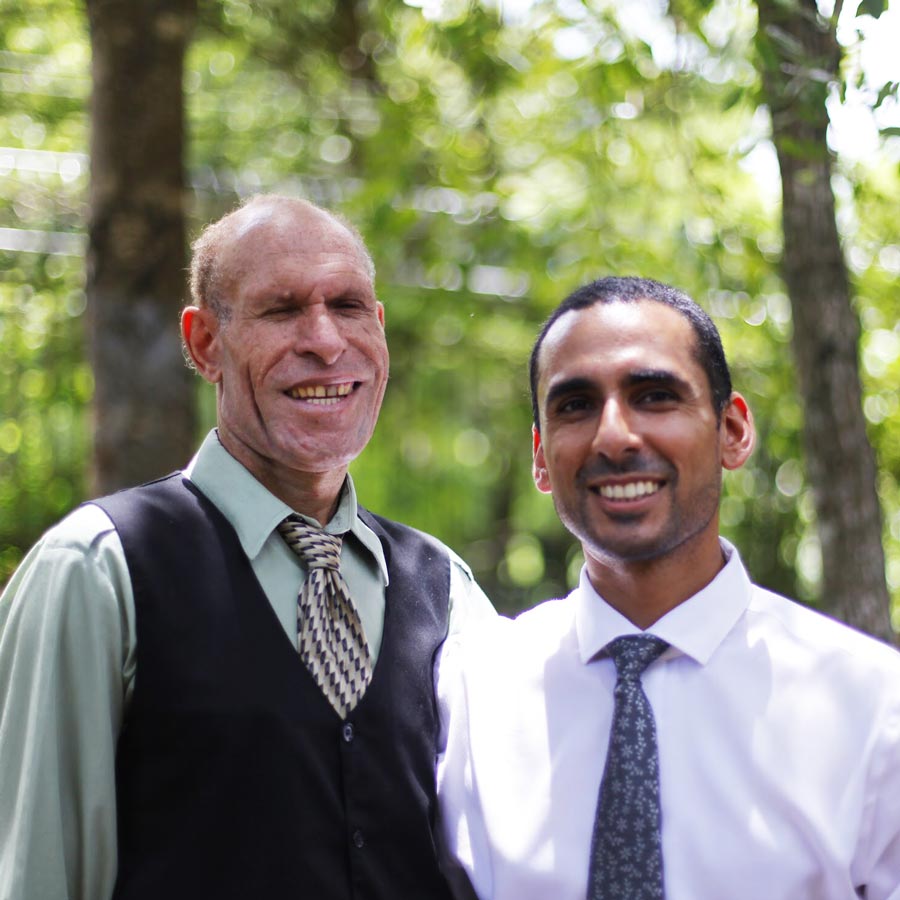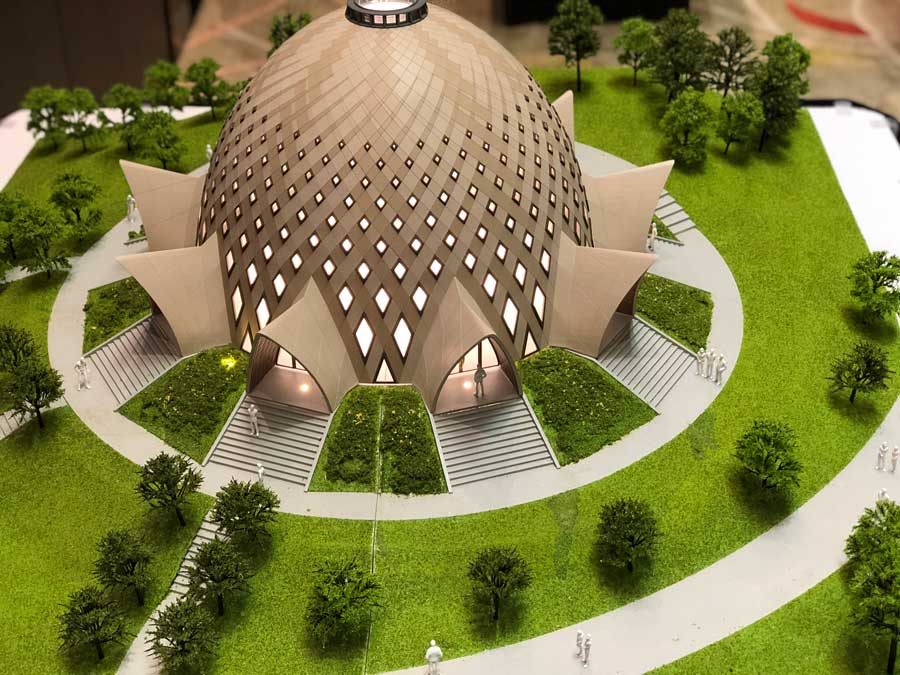Ever wondered about the work that goes into designing and building a Baha’i House of Worship?

Architects Henry Lape (L) and Saeed Granfar (R) responsible for the development of the National Baha’i House of Worship in Papua New Guinea.
BahaiTeachings.org had the special opportunity to chat with architects Henry Lape and Saeed Granfar, who are leading the developments of Papua New Guinea’s first National Baha’i House of Worship. We interviewed them from their office in the country’s capital, Port Moresby, to learn about the location of the temple site, the history and current reality of the Baha’i community, their collaborative design process, new design innovations they’re exploring, the inspiration behind their “woven” structure, the challenges they encountered, their personal reflections, and what this new Baha’i House of Worship will mean for the people of Papua New Guinea.
Baha’i’s don’t only regard Baha’i Houses of Worship as places for prayer, reflection and devotion—but intend these spaces to become spiritual centers for community life, which promote the welfare, development and unification of the entire extended community. Baha’i Houses of Worship bring together people of all faiths and backgrounds, no matter their location, to pray and reflect on both the spiritual and material progress of their communities.
In his Most Holy Book, Baha’u’llah appealed to the peoples of the world to:
Build ye houses of worship throughout the lands in the name of Him Who is the Lord of all religions. Make them as perfect as is possible in the world of being, and adorn them with that which befitteth them, not with images and effigies. Then, with radiance and joy, celebrate therein the praise of your Lord, the Most Compassionate. Verily, by His remembrance the eye is cheered and the heart is filled with light. – Baha’u’llah, The Most Holy Book, p. 29.
In answer to his call, the global Baha’i community has established eight Continental Houses of Worship—one on each of the world’s continents—and have now begun building both national and local Houses of Worship in countries around the world. In a letter addressed to the Baha’is of the world, the Universal House of Justice announced that two countries had met the criteria for the construction of National Houses of Worship: The Democratic Republic of Congo and Papua New Guinea. The House of Justice further shared that:
… the initiation of projects for building national Houses of Worship offers yet another gratifying evidence of the penetration of the Faith of God into the soil of society. – The Universal House of Justice, Letter to the Baha’is of the World, April 2012.
When the National Spiritual Assembly of the Baha’i’s of Papua New Guinea put the call out for design proposals in 2014, both Henry and Saeed submitted separate designs. It was not until 2016 when they began their design collaboration, which took them 18 months to complete, and was officially revealed in a special celebration that took place on top of a mountain at the temple site, in March of 2018. Their collaboration took many months of reflection and consultation with local administrative and Baha’i institutions, an assessment of the complex and diverse cultures of Papua New Guinea, and how those cultures translate into aspects of beauty and sacredness in design. Henry and Saeed even enlisted the help of a local high school to take part in the exploration process.
The result of these efforts lead them to a design that every member of the country’s population could connect with—the basket weave. Seventy-two strands that tell the story of Papua New Guinea’s unification will rise up from the earth and meet at the apex of the dome, the point of unity. Promoting the element of sacredness was a unique challenge for the architects, but by reflecting on the spiritual nature of the population they were able to incorporate traditional elements of local ‘Spirit Houses’ into the nine canopy entrances which will act as the focal point, and which locals can instantly associate with a spiritual space.
… they would assuredly exert the utmost endeavour … to build the [House of Worship], so that the outward frame may reveal the inward reality and the outer form give tidings of the inner meaning. – Abdu’l-Baha, Star of the West, Volume 4, p. 135.
The architects hope other elements of the design stand out, especially the vast carved surfaces on the underside of these woven canopies, and their transition to the inside lining of the structure. These will feature universal themes, quotes and images that local designers and craftsmen will carve into more than 400 square meters of local timber—making this the largest hand-carved exercise in the country. The Baha’i House of Worship will stand out in Papua New Guinea as a welcoming place of reflection and worship, with no clergy or pulpit, and with everyone inside worshipping at a unified level.

a model of the National Baha’i House of Worship in Papua New Guinea.
Locals in Papua New Guinea have already grown conscious of this edifice and are excited and curious for what it will bring to their community. Despite roughly 60,000 registered Baha’is in Papua New Guinea, the Faith is still a relatively unknown religion in Papua New Guinea. Such a structure will help bring the Baha’i Faith out of obscurity in the region, and prompt community members into action, whether by supporting the landscaping, construction, administrative or teaching efforts that surround the temple’s development. Even Baha’is travelling through have been known to bring plants and flowers to the nursery, and offer any type of service that supports the vision of the space.
Particularly in the nations and localities recently designated for the construction of a House of Worship, we have witnessed the friends’ spontaneous expressions of joy; their immediate and heartfelt commitment to lend their share in carrying out the critical work at hand and to increase the dynamism of those activities integral to the emergence of a [Baha’i House of Worship] within a population; their sacrificial contributions of time, energy, and material resources, in a variety of forms; and their sustained efforts to awaken growing contingents to the vision of those edifices dedicated wholly to the remembrance of God that will be founded in their midst. Indeed, the ready response of the community of the Greatest Name augurs well for its ability to further these collective undertakings. – The Universal House of Justice, From a letter dated 1 August 2014 to the Baha’is of the World.
In their interview with Cloud9, architects Henry and Saeed elaborate on the exciting efforts they’ve witnessed from community members in preparation for the Temple’s completion, and their hopes for how the structure will impact local communities. We will learn more about their design collaboration, inspiration and journey; voices and music that we can look forward to hearing inside the Temple; and future plans following the completion of this strikingly beautiful edifice.

Comments
Sign in or create an account
Continue with Googleor